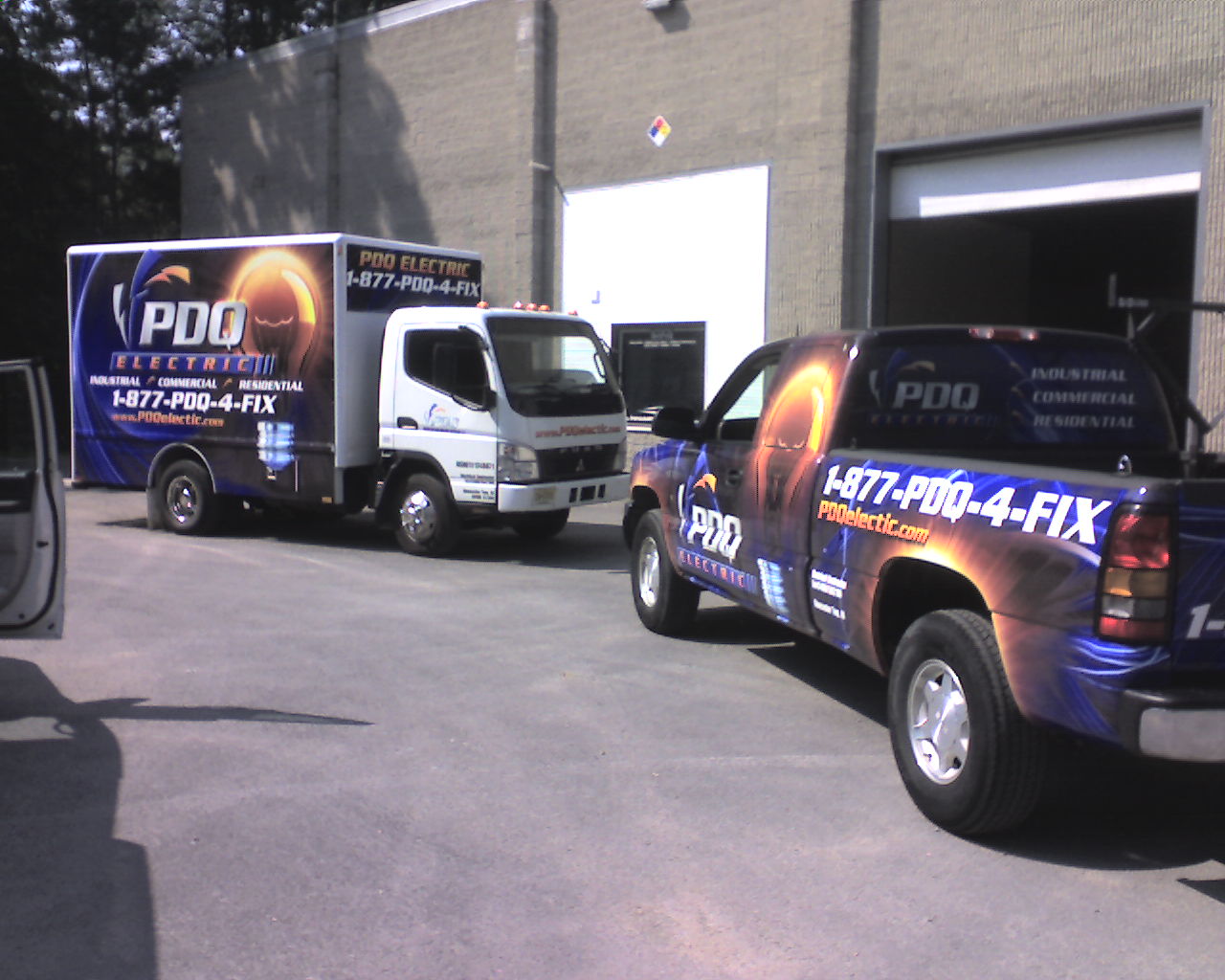 Industrial - Commercial
Industrial - Commercial  Electrical
Contractor
Electrical
Contractor 
PDQ Electric Corp
NJ, PA, DE, MD, NY, CT, DC, MA, RI
|

PDQIE - PDQ Industrial ElectricAnodizing (Electrochemical)
An oxide film can be grown on certain metals – aluminum, niobium, tantalum, titanium, tungsten, zirconium – by
an electrochemical process called anodizing. For each of these metals there are
process conditions which promote growth of a thin, dense, barrier oxide of
uniform thickness. The thickness of this layer and its properties vary greatly depending on the metal, with
only the aluminum and tantalum (and recently niobium) films being of substantial commercial and technological
importance as capacitor dielectrics. Aluminum is
unique among these metals in that, in addition to the thin barrier oxide, anodizing aluminum alloys in
certain acidicelectrolytes produces a thick oxide coating, containing a
high density of microscopic pores. This coating has diverse and important applications including
architectural finishes, prevention of corrosion of automobile
and aerospace structures, and electrical insulation. In fact, it is this
porous coating that is most often thought of as the product of anodizing. Since both barrier and porous
oxides can be grown on aluminum, we will use that metal for most of the examples in the discussion that
follows. The same principles hold for the growth of barrier oxide on other metals.
In an anodizing cell, the aluminum workpiece is made the anode by connecting it to the
positive terminal of a dc power supply. The cathode is connected to the negative terminal of the supply. The
cathode is a plate or rod of carbon, lead, nickel, stainless steel – any electronic conductor that is
unreactive (inert) in the anodizing bath. When the circuit is closed, electrons are withdrawn from the metal at
the positive terminal, allowing ions at the metal surface to react with water to form an oxide layer on the
metal. The electrons return to the bath at the cathode where they react with hydrogen ions to make hydrogen
gas. (See the Appendix for the chemical reactions occurring during this process.)
Bath electrolytes are selected in which the oxide is insoluble, or dissolves at a slower
rate than it deposits, and then an adherent oxide layer grows. The bath composition is the primary determinant
of whether the film will be barrier or porous. Barrier oxide grows in near neutral solutions in which aluminum
oxide is hardly soluble, most commonly ammonium borate, phosphate, or tartrate compositions. Porous oxide grows
in acid electrolytes in which oxide can not only be deposited but also dissolves. The most widely used bath is
dilute sulfuric acid, typically about 1 molar or 10 weight percent concentration. Other baths used for
particular applications are made with oxalic acid or phosphoric acid.
Barrier oxides
Metals that can be anodized also react readily (oxidize) with oxygen in air, so that
under ambient conditions the surface is always covered with a thin oxide film. The details of film structure
and composition depend on the history of exposure to the ambient atmosphere but, on aluminum, there is always a
barrier oxide layer next to the metal that is 2-3 nm thick. The barrier oxide stabilizes the surface against
further reactions with its environment and is an excellent electrical insulator. When an aluminum piece covered
with this oxide is made the anode in an electrolytic cell, containing, say, a borate electrolyte, no
significant current flows until the voltage is raised to between 1 and 2 volt. This oxide supports an electric
field (volts/thickness) of order 1 V/ nm, a very high field indeed. If this were electronic current then water
would be oxidized to evolve oxygen. But oxygen evolution is not seen – it does not occur because the oxide
blocks electrons moving in the direction from electrolyte to metal. The voltage across the oxide can be
increased, without initiating current flow, until the field in the oxide is large enough to drive aluminum and
oxygenions through the oxide. The current through the oxide is an ionic current and these ions react to form
the oxide layer. The process of high-field ionic conduction is central to anodization. Oxide anions move inward
to react with aluminum at the metal/oxide interface to form oxide. Aluminum cations move outward from the metal
to react with water at the oxide/electrolyte interface to form oxide at that surface. At the cathode, the
circuit is completed by the reduction of hydrogen ions to hydrogen gas. New oxide deposits at both oxide
interfaces, as illustrated in Figure 1. (See the Appendix for the chemical reactions occurring during this
process.) The rate at which the oxide thickens is proportional to the current density (A/cm2). The
field in the oxide does not change with oxide thickness, and has only a small dependence on current density and
temperature. As the oxide thickens the voltage across the oxide increases proportionally, and at room
temperature the thickness/voltage ratio is close to1.2 nm/V. Thickness is very uniform across the surface
because everywhere the voltage drop must be the same.
For each bath composition and temperature, there is a maximum voltage that can be
supported before breakdown occurs. At breakdown, reactions other than oxide growth occur: oxygen evolution,
soluteoxidation, or sparking due to electron avalanche through the oxide. The more dilute the
electrolyteconcentration, the higher the breakdown voltage, and the highest voltage that is reached in aqueous
electrolytes is about 1000 V. At this voltage the barrier oxide is about one µm thick, 300 to 500 times thicker
than the ambient native oxide.
Barrier oxide deposited on clean aluminum at room temperature has an amorphous
(non-crystalline) structure, that is, its x-ray diffraction pattern is a diffuse halo. Figure 2 shows a cross
section of an amorphous oxide grown at
a fixed current density of 10 mA/cm2 in 0.16 M
ammonium tartrate at 20oC (68oF) to a voltage of 200 V. The oxide
thickness is 220 nm, equivalent to 1.1 nm/V. As expected for an amorphous structure, there are no
distinguishing structural features. The micrograph in Figure 2 (and also in Figure 3) was obtained using a
transmission electron microscope, which can show fine detail at very high magnification.
Modifying the initial native oxide in certain ways, for example, by heating in air at
high temperature, and then anodizing at elevated temperature produces a barrier film that is crystalline.
Figure 3 shows plan view and cross section of a crystalline barrier oxide grown to 140 V. The fine,
nanocrystalline structure of the oxide is evident in the plan view. Crystallites with different orientation
create the distinctive texture in the cross section. To get this structure the aluminum was initially heated at
550oC (1022oF) for 30 seconds. The amorphous oxide that grows during this brief exposure
to air at high temperature is only slightly thicker than the usual ambient temperature film, but it probably
contains "seeds" of the crystalline oxide that has been identified in films grown over longer time at this
temperature. During subsequent anodization at 70oC (158oF), these seeds promote growth of
a uniform crystalline phase. To move aluminum and oxygen ions through the crystalline oxide requires a higher
field than in amorphous oxide, so a thinner crystalline oxide supports the same voltage as a thicker amorphous
oxide. The film in Figure 3 is 125 nm thick, equivalent to 0.90 nm/V. Crystalline oxide is advantageous as
a capacitordielectric, because a thinner dielectric results in a higher
capacitance.
Porous anodic oxides
Porous aluminum oxides are most commonly grown in dilute sulfuric acid, typically 10
weight percent concentration, but there also are commercial processes using phosphoric acid, chromic acid,
oxalic acid, and mixtures of inorganic and organic acids. A feature common to these anodizing baths is the
ability to retain a relatively high concentration of aluminum in solution. This is essential, because a large
fraction of the aluminum that is oxidized is not retained in the film, but passes into solution. For example,
for anodization in sulfuric acid, about 60% of the oxidized aluminum is in the film and the remainder is found
in solution. Porous films 100 µm thick can easily be made – this is 100 times thicker than the thickest barrier
film. Unlike barrier films, a high voltage is not needed to make a thick porous film because of the unique
structure of these films.
An idealized sketch of film structure is shown in Figure 4. The oxide has a cellular
structure with a central pore in each cell. The sketch shows uniform hexagonal cells, but most anodization
conditions produce films with more disorder, with a distribution of cell size and pore diameter. Cell and pore
dimensions depend on bath composition, temperature, and voltage, but the end result always is an extremely high
density of fine pores. The cell diameter is in the range 50-300 nm and the pore diameter is typically 1/3 to
1/2 of the cell diameter. The cell population density is from approximately 10 to more than 100 per
µm2. The aspect ratio is even more startling – commonly of the order of 1000:1. For example, film
thickness of 20 to 50 µm with 20 nm pores is typical for coatings grown in sulfuric acid.
Figure 5 shows two views of a fracture section of a 9.4 µm thick film grown in sulfuric acid. These images were made in a scanning
electron microscope, which shows surface features. At 3,500× magnification the fine porous structure is
not evident but at 40,000× the pores and cell walls are clearly seen.
Figure 6 shows the surface region of another film grown in sulfuric acid. The structure is the same across the
coating thickness.
A thin barrier oxide is at the base of each pore. Figure 7-top shows a film in the
vicinity of the metal/oxide interface that was grown in phosphoric acid. This is a transmission electron
micrograph of a carbon replica of the fracture surface. Four pores are in the micrograph, and each pore is
centered over a scallop-shaped depression in the metal. At the base of each pore is anodic oxide 0.2 µm thick
and pores are separated by oxide comprising the cell walls. As illustrated in Figure 7-center, the cell
geometry concentrates current through the oxide at the pore base, the dark grey zones in the figure. The
shortest path between metal and electrolyte is within this zone, and the field is uniform and at its highest
value. This is a critical feature for development of the porous structure. Ions move by high field conduction:
aluminum cations reach the pore surface and pass into solution, and oxide deposition is confined to the
metal/oxide interface at the pore base. As aluminum metal is oxidized, the metal/oxide interface moves into the
metal. This is illustrated in Figure 7-bottom where we try to show this inward motion by superposing the pore
positions at an earlier and later time of anodization. What had been barrier oxide at the periphery of the pore
base is no longer penetrated by the field and becomes part of the cell wall. The cell wall and pore increase in
height, that is, the film thickens, while cell and pore diameters remain fixed. Because the barrier oxide
thickness remains constant, the cell voltage and current remain nearly constant as the film
thickens.
It is not apparent from this description of steady state film growth how the pores and
cells initiate. The metal surface has some degree of roughness. This may be from a metal fabrication process,
such as rolling, or from chemical etching, or cleaning prior to anodizing. Even electropolishing, which leaves
a mirror finish, creates a scalloped surface texture with shallow cells of the order 100 nm diameter. During
early growth, the film on ridges and protuberances becomes thicker than in the depressions. It appears that
ions move through oxide more easily at these locations. This may be because of higher film stress, impurities,
or oxide flaws, and so the current concentrates at these locations. This is a temporary situation and as the
oxide acquires more uniform properties the current shifts towards the thinner oxide in depressions. Because of
the concave geometry that has developed, there is a slightly higher electric field in depressions, and
field-assisted dissolution promotes local oxide thinning and current concentration. This initiates pores, and
the pore size, density, and distribution adjust until steady state prevails. For commercial processes most of
the adjustment typically occurs within the first minute.
The usefulness of these films would be quite limited if it were not possible to close the
pores after growth is completed. This step is called "sealing," and is most commonly done by reacting the
anodized coating with hot water. Oxide on the surface and within the pores reacts to make a hydrous oxide that
has a different structure, and a lower density, than the anodic oxide. Because of its lower density, the
hydrous oxide occupies a greater volume than the anodic oxide from which it formed. This reaction product fills
the pores and makes an impermeable anodized layer that is stable under a wide range of atmospheric and
environmental conditions. (See the Appendix for the chemical reaction occurring during sealing.)
Applications
A few of the more important applications are described below, as well as new nanotechnology applications that
may grow in importance.
| ||||||||||||||||||||||||
 |
| Fig. 8. Process for fabrication of ideally ordered porous oxide. Black structure is SiC (silicon carbide) mold used to make ordered array of convex dimples in aluminum surface prior to anodization (From Asoh et al., see Bibliography). |
 |
| Fig. 9. Scanning Electron Microscopy micrograph of surface showing ideally ordered pores (left) and usual random distribution (right) (From Asoh et al., see Bibliography). |
 |
| Fig. 10. Carbon tubes prepared by pyrolytic deposition of carbon in porous aluminum oxide (From T. Kyotani, L. Tsai, and A. Tomita, Chemistry of Materials, Vol. 8, p 2109, 1996). |
 Electrolytic capacitors
Electrolytic capacitors
The main commercial application of the anodic barrier oxide is as the dielectric film in electrolytic capacitors. These capacitors have high energy density, wide voltage range (3 volt to 600 volt) and are relatively low cost. These capacitors are of two types: wet and solid. Wet type uses an organic electrolyte as electrical contact between oxide dielectric and a current collector. Most aluminum electrolytic capacitors are of this type and contain a roll of two aluminum foils – one foil with the oxide dielectric – separated by a paper spacer impregnated with the organic electrolyte. Solid capacitors use a conducting oxide, usually manganese dioxide, or a conducting organic polymer (for example, polythiophene) as the contact between oxide dielectric and current collector. These are mostly tantalum capacitors, although there are some aluminum and more recently niobium capacitors with this design. To enhance the capacitance per unit volume, the surface area of metal substrate is increased before deposition of the anodic oxide dielectric. Aluminum foil is etched and tantalum or niobium powder is sintered to make a high surface area pellet. The high specific area, thin dielectric layer, and relatively high dielectric constant (about 8 for aluminum oxide and 25 for tantalum oxide) combine to make capacitors with higher energy density than with any other type of dielectric, such as polymer film or ceramic.
Appendix
 Summary of anodizing and sealing
reactions
Summary of anodizing and sealing
reactions
The overall reaction that takes place during anodization is:
2Al + 3H2O ==> Al2O3 + 3H2
This is the sum of the separate reactions at each electrode. The reactions at the anode occur at the metal/oxide and oxide/electrolyte interfaces. The ions that make up the oxide are mobile under the high field conditions. At the metal/oxide interface the inward moving oxygen anions react with the metal:
2Al + 3O2- ==> Al2O3 + 6e-
At the oxide/electrolyte interface outward moving aluminum cations react with water:
2Al3+ + 3H2O ==> Al2O3 + 6H+
(In case of aluminum dissolution into the electrolyte during porous film formation, the anodic reaction is:
2Al ==> 2Al3+ + 6e-)
The reaction at the cathode is hydrogen gas evolution:
6H+ + 6e- ==> 3H2
The sealing reaction can be written as:
Al2O3 + 3H2O ==> 2AlOOH*H2O
Bibliography
- Structural Features of Crystalline Anodic Alumina Films, H. Uchi, T. Kanno, and R. S. Alwitt, "Journal of The Electrochemical Society" Vol. 148, pp B17-B23, 2001.
- Conditions for Fabrication of Ideally Ordered Anodic Porous Alumina Using Pretextured Al, H. Asoh, K. Nishio, M. Nakao, T. Tamamura, and H. Masuda, "Journal of The Electrochemical Society" Vol. 148, pp B152-B156, 2001.
- The Surface Treatment and Finishing of Aluminum and Its Alloys (5th edition), S. Wernick, R. Pinner, and P.G. Sheasby, ASM International, Metals Park, Ohio, USA, 1987.
- Crystalline Aluminum Oxide Films, R. S. Alwitt and H. Takei, in "Thin Films Science and Technology, Vol. 4, Passivity of Metals and Semiconductors" pp 741-746, M. Froment (editor), Elsevier, New York, 1983.
- Anodic Films on Aluminum, G. E. Thompson and G. C. Wood, in "Treatise on Materials Science and Technology, Vol. 23, Corrosion: Aqueous Processes and Passive Films" pp 205-329, J. C. Scully (editor), Academic Press, New York, 1983.
PDQIE, www.PDQIE.com, info@PDQIE.com, quote@PDQIE.com, Ryan@PDQIE.com, PDQ Industrial Electric, www.PDQIndustrialElectric.com, info@PDQIndustrialElectric.com, quote@PDQIndustrialElectric.com, Ryan@PDQIndustrialElectric.com are marketing tools of PDQ Electric Corp, a NJ Licensed Electrical Contractor. Reddy Kilowatt® is a Registered Trademark of Northern States Power Company. The information on this website is believed to be reliable, but we cannot guarantee that information will be accurate, complete and current at all times and should be reaffirmed by a licensed professional before relying on it. PDQIE will from time to time revise information, products and services described in-on this Website, and reserves the right to make such changes without notice. Use of this Website is entirely at your risk. Materials and information in this Website (including text, graphics, and functionality) are presented without express or implied warranties of any kind and are provided "as is". It is your responsibility to evaluate the accuracy, completeness and usefulness of any opinions, advice, services and information provided.









